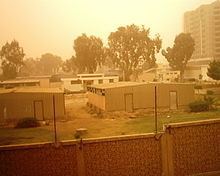 | ||
Khamsīn , chamsin or hamsin (Arabic: خمسين khamsīn, "fifty"), more commonly known in Egypt as khamaseen (Egyptian Arabic: خماسين khamasīn, [xæmæˈsiːn]), is a dry, hot, sandy local wind, blowing from the south, in North Africa and the Arabian Peninsula. Similar winds in the area are sirocco and simoom. From the Arabic word for "fifty", throughout the Levant, these dry, sand-filled windstorms often blow sporadically over a fifty day period in Spring, hence the name.
When the storm passes over an area, lasting for several hours, it carries great quantities of sand and dust from the deserts, with a speed up to 140 kilometers per hour, and the humidity in that area drops below 5%. Even in winter, the temperatures rise above 45°C due to the storm. The sand storms are reported to have seriously impeded both Napoleon's military campaigns in Egypt as well as Allied-German fighting in North Africa in World War II.
The Causes and history
Khamsin can be triggered by cyclones that move eastwards along the southern parts of the Mediterranean or along the North African coast from February to June.
In Egypt, khamsin usually arrives in April but occasionally can occur between March to May, carrying great quantities of sand and dust from the deserts, with a speed up to 140 kilometers per hour, and a rise of temperatures as much as 20 °C in two hours. It is believed to blow "at intervals for about 50 days", although it rarely occurs "more than once a week and last for just a few hours at a time." A 19th-century account of khamsin in Egypt goes:
These winds, though they seldom cause the thermometer of Fahrenheit to rise above 95° in Lower Egypt, or in Upper Egypt 105°, are dreadfully oppressive, even to the natives. When the plague visits Egypt, it is generally in the spring; and the disease is most severe in the period of the khamáseen.
The same account relates that Muslims in Egypt "calculate the period of [khamaseen] ... to commence on the day immediately following the Coptic festival of Easter Sunday, and to terminate on the Day of Pentecost (or Whitsunday); an interval of forty-nine days."
During Napoleon's Egyptian Campaign, the French soldiers had a hard time with khamsin: when the storm appeared "as a blood-stint in the distant sky", the natives went to take cover, while the French "did not react until it was too late, then choked and fainted in the blinding, suffocating walls of dust." During the North African Campaign of the World War II, "allied and German troops were several times forced to halt in mid-battle because of sandstorms caused by khamsin ... Grains of sand whirled by the wind blinded the soldiers and created electrical disturbances that rendered compasses useless."
In Israel, khamsin (Hebrew: חמסין) is known more formally as sharav (שרב), and the Biblical term for khamsin is ruaḥ qadīm (רוח קדים) or "east wind".
